by NIGEL SARRASSA-DYER
Twenty-six episodes. Writers: Keith Waterhouse, Willis Hall, Douglas Livingstone, Jack Trevor Story; Producer: Verity Lambert; Directors: Moira Armstrong, Alan Gibson, Michael Lindsay-Hogg, Mike Newell, Herbert Wise
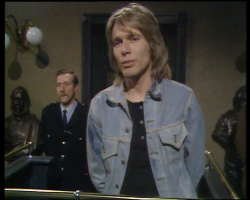
Budgie, the story of small time Soho criminal Ronald ‘Budgie’ Bird, was produced by London Weekend Television and ran over two series, each of thirteen episodes, between 1971 and 1972.1 Both series explored the liminal world of pornography, police corruption, criminal scams, violence and petty crime, and Budgie’s place within it. While Budgie has come to be affectionately remembered as a cockney comedy-drama with a charming, irrepressible lead character set in 1970s Soho, and as a series which launched an ‘entire fashion craze’, and is indeed all of these things, it would do the series a huge disservice to ignore its other dimensions, in particular those concerned with gender and masculinity identity.2
As social, economic and cultural changes of the 1970s impacted upon gender relations, a significant number of programmes were able to explore multiple and competing constructions of masculinity. Issues around gender and masculine anxieties featured across a variety of television genres: routinely in sitcoms such as Rising Damp and Man about the House;3 as small parts of wider discourses in dramas like The Knowledge and Comedians;4 and in both the documentary The Family and the science fiction series Survivors.5 With Budgie, however, it is the detailed examination of a particular masculinity at a particular time which is central to the narrative as it is played out in the trajectory of Budgie’s decline and fall.
The series was devised and largely written by Keith Waterhouse and Willis Hall, who had achieved considerable success the previous decade. Echoes of Budgie can be found in some of Waterhouse’s earlier writing. For example, William Fisher in the 1959 novel Billy Liar (later adapted for theatre and cinema by Waterhouse and Hall) is, like Budgie, a dreamer and a fantasist. Similarly Waterhouse and Hall’s script for the 1963 film West 116 depicts a particular milieu in London (in this case Notting Hill rather than Soho) in a decade (the 1960s rather than the 1970s) which is part ‘seedy’, part swinging, part ‘sleazy’ and peopled by richly idiosyncratic characters.7 Even Alfred Lynch’s central character Joe Beckett, while more intelligent and aware than Budgie, bears a striking resemblance to him as a somewhat confused outsider on the fringes of the criminal underworld. Some of Waterhouse’s later work also has echoes of Budgie. His novel Soho, for example, is set in the district that he knew and loved and was on the verge of disappearing. Similarly his script for the play Jeffrey Bernard is Unwell operates, in part, as an elegy or paean for a particular time and place displaying his love for and knowledge of that part of London, something which is no less apparent in Budgie.
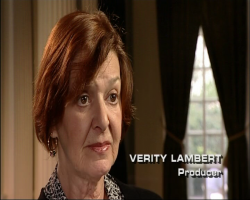
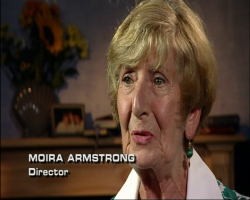
Budgie was notable for the involvement of producer Verity Lambert, following her considerable success with Doctor Who and preceding her groundbreaking achievements with Euston Films.8 A number of distinguished directors were also involved in the production including Jim Goddard who would go on to direct Out, Fox and The Black Stuff;9 Michael Lindsay-Hogg, whose later work would include several episodes of Play for Today, Brideshead Revisited and Bill Brand);10 Mike Newell, who had been building a reputation for himself with crime dramas Spindoe and Big Breadwinner Hog and whose later work would take him to Hollywood;11 and BAFTA-winning Moira Armstrong, whose career as one of television’s most prolific directors of popular drama, spanning fifty years, would include the acclaimed series Testament of Youth.12
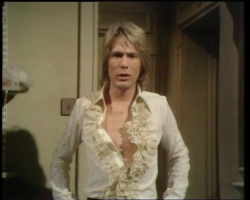
Budgie starred pop singer Adam Faith, who had already made successful forays into acting in a number of British films. Faith’s personification of Budgie, which became enormously popular with a young male working class audience, is perhaps one of the best fictional examples of what came to be known as The Lad.13 Variously described by Robert Elms as ‘a guttersnipe peacock’, ‘Jack the Lad’ and ‘a cheeky, money hungry, street savvy working class guy, obsessed with wearing the right schmutter’, Budgie Bird was able to encapsulate the aspirations of a large and significant section of working class youth.14 In this sense he personifies what Caughie and Rockett have called the crafty working-class lothario.15 Being highly aware of his own image and style, confident as an individual and not necessarily operating as part of a homosocial male group, but still holding an unreconstructed attitude towards women, he is perhaps more likely to be seen in the company of women than other men. However, he is less interested in the women than he is in himself. Furthermore, unusually for the time, whilst being resolutely heterosexual Budgie eschews any form of homophobia. Unlike other characters in the series he is neither abashed nor appears threatened when confronted with openly camp men or evidence of same sex liaisons.
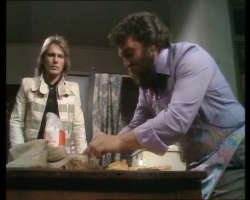
In the early 70s advertisers made a concerted effort to target male consumers, resulting in the emergence of a new language. Whilst traditional masculine products such as beer and tobacco were marketed more aggressively, new more ‘feminine’ products like aftershave also entered into advertising. Leon Hunt sees here the emergence of The Lad, a generally younger man, part pop star, part footballer, willing to incorporate elements of femininity into his lifestyle.16 The Lad is resolutely heterosexual but is open to new ideas, styles and fashions. His version of masculinity is fluid but can also be awkward, comic and somewhat vulnerable.17 What he also contributes is a distinctly accessible role model for working class youth and a break with models of traditional working class masculinity, although whether this is a genuine challenge to the dominant paradigms of hegemonic masculinity is debatable.18
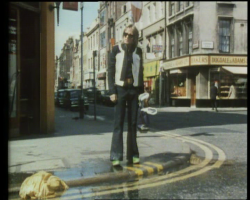
While working-class men’s interest in designer clothes was a reflection of masculinity that had ‘partly detached itself from its formative links to traditional class identities’, becoming ‘aspirational and more narcissistic’, Budgie was far from the upper-middle-class fantasies of Jason King and The Persuaders,19 its central character owing more to the legacy of dandyism which emerged in working-class personalities like Terence Stamp in the 1960s.20 If, as Robert Shail has argued, figures like Stamp and Michael Caine personified a particular form of metropolitan working class masculinity and they themselves constituted a considerable part of the new meritocracy of the sixties, then Budgie could be seen as the 1970s corollary to this phenomenon.21 With his optimistic approach to life he comes over like a 1960s anachronism, the working class dandy. His look certainly suggests success and affluence with his feathered haircut, flamboyant Carnaby Street suits, tight fitted suede jackets, satin trousers and white clogs. However, the reality of his situation more accurately reflects the ostensible disillusion of the 1970s. His milieux are not galleries, exclusive clubs or chic discothèques, but strip clubs, gambling dens and dirty bookshops. His escorts are not fashion models and actresses but strippers and check out girls, and the closest he gets to position and status is as the errand boy for a much more successful and socially aspirational working class villain. He is a character who finds every available opportunity for success thwarted as he finds it increasingly impossible to transcend his roots and his place in society. If, as Shail asserts, ‘the exuberance which marked the working-class emancipations of the early 1960s’ led to a dandified, meritocracy in certain circles, then from the ‘besieged mentality’ of the 1970s emerged a masculinity, based upon this meritocracy but without many of the concomitant attributes.22 The best Budgie can do is look the part.
While on the surface Budgie appears to epitomise The Lad, a working class consumer, confident, stylish and irrepressible, the narratives of both series tend to undercut this image, while providing a space for a deeper exploration of Budgie’s own masculine frailty. Despite operating on the fringes of Soho’s criminal world, participating in numerous scams, continually trying to get one over on other characters, it is Budgie himself who is more often, ironically, portrayed as the victim. While he is never violent himself, he is, at times, on the receiving end of violence. While being relatively insensitive to the feelings of Hazel, his girlfriend, and some of his associates he does at other times display a deeply moving sensitivity to others. In an encounter with his former teacher in ‘Could do Better’, he spends much of the episode listening to the man recount his lonely life since his wife left him.23 In ‘Twenty-Four Thousand Ball Point Pens’ he has serious doubts about participating in a scam which would leave an elderly woman out of pocket.24 Even more poignantly in ‘Sunset Mansions, or Whatever Happened to Janey Baib?’ he forms a genuine and affectionate relationship with a somewhat proud but deluded middle aged actress, attempting to comfort her and shield her from the reality of her faded career.25
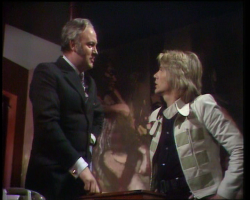
It is however in the rejection and abuse that he receives at the hands of Charlie Endell, his sometime boss, where his vulnerability reveals itself in a mixture of hurt and bewilderment. Budgie looks to Endell as a mentor, someone to nurture him. He wants to be taken seriously by Endell both professionally and personally; Endell, however, sees Budgie as no more than a minion, and certainly does not want him involved with his own private life or his family. He constantly ridicules Budgie’s attempts to be a real villain, berates him for not understanding the complexities of business, threatens him if Budgie’s actions might lead to Endell’s own wife becoming upset. It is Endell who finally arranges for Budgie to be tracked down and badly beaten for his transgressions.
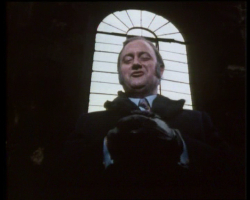
In the final episode of the second series, Budgie ultimately realises the reality of a masculine hierarchy which positions himself at the bottom and Endell at the top. ‘It ain’t a free country, only for the biggest’, he cries. This is followed by a highly symbolic scene in the grounds of a ruined church, accompanied by the sound of church bells, a low angle shot of Endell, silhouetted against the ruins, looming over a quailing Budgie pleading against his punishment.26
While Budgie appears to see Endell as some kind of surrogate father figure, Endell does not treat Budgie like a son. Why Budgie has turned to Endell to fulfil this role becomes clear in the two-part story ‘Fiddler on the Hoof’, where his real father is revealed as dissolute, uncaring and highly critical of his son to the point of antagonism.27 In a later episode Budgie’s father fails to inform Budgie of his mother’s death. The most moving scene however, which underscores Budgie’s own vulnerable sensitivity and the lack of sensitivity that others have for him, is when his family and friends gather together to celebrate his sister’s wedding and his errant father turns up only to rant and rail once again against his son. When the family are forced to choose who stays at the party and who goes, it is Budgie who is asked to leave.
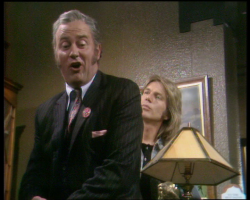
Budgie expresses a disjuncture between male identities founded upon the mythic and reality, between men’s expectations and experiences, and it is indeed the theme music which frequently highlights this. The lyrics used for the second series operate as a litany of maudlin self pity: ‘I’m nobody’s fool and I’m nobody’s friend’. This elegy continues with the line ‘nobody notices me’, reflecting the eponymous protagonist’s inability to engender any heroic qualities to elevate his endeavours to mythic status. For Budgie there is no possibility of (to use Jefferson’s terms) ‘transcendence’ from the ‘mundane’.28 Indeed the overall narrative trajectory of Budgie’s story, as well as for each individual episode, serves to play out this impossibility. Thus, rather than establish any mythic or heroic status for Budgie, the narrative(s) resolve themselves in a sense of melancholia.
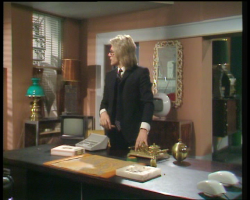
Jonathan Rutherford has talked about the broken promises of patriarchy where men invest the meanings of themselves in the structures and images of male superiority. That is where the promise of patriarchy is supposed to lie, in dreams of fame, greatness and of being someone. Yet these dreams rarely bear fruition. The reality of class and racial hierarchies ensure that the majority of men wait for a payoff that rarely comes. What ensues is the ‘bitterness and disappointments of men let down by the broken promises of patriarchy’, the intangible goals of masculinity that never materialise, ‘yet he still feels at home in his sexual identity rather than make any attempt to change it’.29 As Roger Horrocks has observed, ‘patriarchal society has demanded and constructed a fearsome male narcissism’.30 Ultimately, as Budgie’s attempts to achieve mythic status constantly elude him his geniality and the optimism, apparent in the first series, begin to evaporate and the bitterness and disappointment that Rutherford describes become increasingly manifest.
While Budgie conforms to Hunt’s definition of the 70s working class ‘Lad’, confidently embracing the ostensibly ‘feminine’ through clothing, style and consumption while retaining many of the characteristics of the dominant paradigms of masculinity, his real persona is far more complex.31 With its melancholic theme music used for the first series, plaintively-voiced lyrics for the second series, and narratives which emphasise rejection and failure, Budgie reveals its namesake to be far more than a mere signifier for youthful masculine confidence in the 1970s. Budgie himself is lonely and confused, confronted by his own inability to achieve, to become the equivalent of pop star or footballer. More than this, his own apparently confident masculinity becomes increasingly vulnerable, bringing him at times close to tears in a state of bewilderment at the treatment he receives from those he cares for. Ultimately, Budgie is revealed to be equally The Lad and The Loser.32
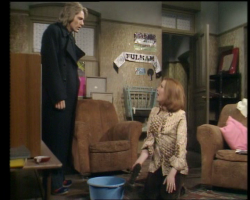
While Budgie is the recipient and beneficiary of a wave of trickling down of 1960s permissiveness together with a more relaxed attitude towards gender differences, he continually resorts to manoeuvres which owe more to the power/gender relations of a previous generation.33 Indeed while the age appeared to be permissive, this permission appears to have been granted almost exclusively to men. While Budgie exemplifies this permissive populism this is still purely a male domain. Power and gender relations remain the same. Men are still in charge; patriarchy still exists, men still exercise power both inside and outside mainstream culture. Consequently those men with little power within the masculine hierarchy, like Budgie, attempt to exercise power at moments of conspicuous success – affirming their masculinity through clothes and money or at all other times through casual misogyny. Thus, the notion of The Lad as a new construction of masculinity is both meretricious and superficial – the only thing new about him is his style. While Budgie’s masculine performance ostensibly betrays a degree of fluidity the reality becomes increasingly apparent as his aspirations are thwarted.
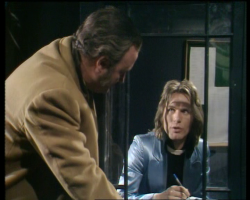
In the first series Budgie is at times charming, sensitive, charismatic and appealingly irrepressible. His style and appeal allows one to overlook his shortcomings. Furthermore the fact that he is a loser allows for a sense of sympathy (at his plight). However, in the second series this idea is turned on its head. His irrepressible nature – having ‘stood for it’ once again – can only be seen as stupidity. And his actions and attitudes, largely through repetition but also through making them increasingly extreme, make the character far less appealing. In ‘Glory of Fulham’, for example, as success once again eludes him, he becomes more bitter and misogynistic.34 With his jibes about ’women’s lib’ (an echo of Bob Hope’s tirade at Miss World 1970), his exploitation of others, particularly Hazel, becomes more cynical. As he becomes more anxious and his always precarious masculine privilege becomes ever more insecure, his actions are revealed as increasingly pitiful, his behaviour problematic and no longer amusing. As people become less tolerant of him he attempts to assert himself, less through charm and more through direct challenge and confrontation. As his protracted domestic squabbles with Hazel become increasingly bitter, he states that their young son is ‘your lousy kid’, complains that the child’s crying has woken up his racing greyhound (his latest doomed venture) and threatens violence against Hazel. Even his sexual allure begins to evaporate as he becomes sleazier, his lasciviousness becoming almost predatory. Gradually through the last three episodes, comedy turns to tragedy. This is not simply the tragedy of his own position but also the tragedy he brings upon others (again particularly Hazel) through his thoughtlessness and selfishness. In spite of its comic moments, the mood of the series has darkened considerably.
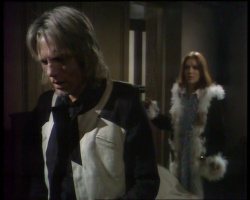
Ultimately, while Budgie has come to be fondly remembered as a light drama, with comedic moments, depicting a likeable character’s laddish behaviour and a fixation on clothes, set in a fictional depiction of a lost Soho and its 70s criminal world, it is much more than this.35 It is a complex examination of working class masculinity through a relatively simple and naïve male character. However, while it opens up interesting discourses around a particular emergent masculinity, any genuine fluidity or transcendence is heavily circumscribed throughout the narrative leaving Budgie trapped within the existing/persisting class structures, the dominant constructions of masculinity and the limits of his own cognitive abilities. While the series may have constituted part of a shift in representations of masculinity, it was less than a radical challenge to the privileges of patriarchy. While it shows increasing tolerance to non-normative behaviour it nevertheless retains strong elements of misogyny at moments of crisis reverting to residual constructions of masculinity. As Budgie’s desperation becomes more palpable, so his mood degenerates into dark self pity. This has become, ultimately, masculinity at the end of its tether, as he declares in the final scene, ‘You can’t win, this thing’s bigger than the both of us. It’s the whole bleedin’ system’.
Images of Moira Armstrong and Verity Lambert are taken from the documentary Budgie’s Birds, which is on the Network DVD release of Budgie.
Originally posted: 17 February 2016.

Pingback: Impish Hillmans – Dreams Gathering Dust